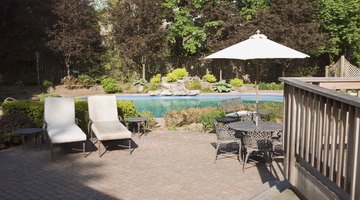How to Cover a Brick Patio With Cement
Changing the look of a brick patio is a difficult process without removing all of the bricks and placing them in a different pattern or laying different bricks entirely. An alternative to such a high-labor endeavor does exist, though. By covering the bricks with a layer of cement-based concrete, you can create a new patio surface that gives the appearance of a solid slab without the need for demolition of the brick patio below. The new surface, poured into place over and around the bricks, conceals the old surface completely, saving brick removal time as well as the cost of pouring a full slab.

Things You Will Need
- Power washer
- Wooden planks
- Hammer
- Nails
- Exterior epoxy primer
- Paint roller
- Concrete mix
- Concrete mixer
- Spade
- Screed board
- Wood float
- Trowel
- Concrete sealant spray
-
Clean the surface of the bricks with a power washer to remove any dirt or debris. Set the washer as high as the brick-and-mortar surface can stand, starting with a low setting and testing increasingly higher settings with the washer on an unobtrusive corner of the brick patio, until the water begins to etch the surface. Dial the setting back slightly at that point, then wash the patio from the entrance to your home to its edge with the water stream. Allow the bricks and the surrounding lawn to dry out before continuing.
-
Build a wooden form surrounding the patio extending up to 2 inches above the patio surface and 2 inches from the patio edge. Do not raise the level of the form higher than the threshold of any entrance leading to the patio. Use wooden planks for the form, nailing them together at the joints and using the edge of your home as the fourth wall of the form. Place the frame around the patio, and secure it into place by driving stakes into the ground surrounding the frame, then nailing the stakes into place.
-
Apply a layer of exterior epoxy primer to the bricks with a paint roller. The primer will seal the bricks, keeping them from absorbing the moisture from the cement covering. Allow the primer four hours of drying time.
-
Mix a batch of Portland cement-based concrete in a cement mixer, adding the dry concrete mix to the rotating mixer before adding enough water to create a pourable concrete. Mix until the concrete is smooth and lump-free.
-
Pour the concrete over the brick patio and to the edges of the form surrounding the brick surface, filling the form to the top. Spread the mix evenly over the bricks, using a spade.
-
Level the concrete covering the brick patio with a screed board. Drag the screed board across the concrete along the top of the form, moving it in a sawing motion to fill in voids in the surface of the concrete with any material sitting in high spots.
-
Drag a wood float across the surface of the concrete to smooth it further as well as bring a bit of moisture to the top. Wait for the moisture to be absorbed back into the concrete and then cut control joints in lines across the surface every 8 feet with the trowel’s edge, about 1-inch deep into the concrete, to allow for expansion and contraction of the concrete.
-
Cover the concrete with a plastic sheet and allow it to cure for seven days, removing the sheet once a day for the first two to mist the surface with water, preventing early drying.
-
Remove the forms from around the concrete and cure for a further 13 days. Spray the concrete with concrete sealer, then wait 72 hours more before using the new concrete patio.
Tip
Stamp your new cement patio surface with concrete stamps to create a decorative look.
References
Writer Bio
Larry Simmons is a freelance writer and expert in the fusion of computer technology and business. He has a B.S. in economics, an M.S. in information systems, an M.S. in communications technology, as well as significant work towards an M.B.A. in finance. He's published several hundred articles with Demand Studios.
Photo Credits
- Jupiterimages/Comstock/Getty Images
- Jupiterimages/Comstock/Getty Images
More Articles



